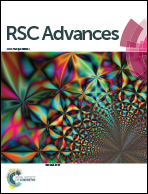Electrocatalytic activity of a nitrogen-enriched mesoporous carbon framework and its hybrids with metal nanoparticles fabricated through the pyrolysis of block copolymers†
Abstract
Nanostructures with a nitrogen-enriched mesoporous carbon framework (NEMCF) were prepared through a simple carbonization of cross-linked polystyrene-block-poly(2-vinylpyridine). NEMCF has a rich mesoporosity because of the morphological fidelity upon cross-linking and carbonization. Hybrids of NEMCF with metal nanoparticles (i.e., Ag@NEMCF) or binary metal alloys (i.e., Ag–Au@NEMCF) were prepared through a photochemical reduction or a photochemical reduction and galvanic replacement in combination. The inner architecture, the chemical composition and the graphitization of NEMCF and NEMCF-supported metal nanomaterials were studied with electron imaging, X-ray and Raman scattering, and electron spectra; the electrocatalytic activity of oxygen reduction in a basic electrolyte was measured with a rotating disk electrode. The nitrogen configurations of NEMCF were dominated by pyridinic and pyrrolic nitrogen, so that NEMCF displayed a two-electron transfer pathway for the oxygen reduction reaction (ORR). As Ag NPs and Ag–Au alloys composed of minor Au and major Ag were incorporated within the NEMCF matrix, a four-electron transfer pathway, a large kinetic current density and a small onset potential were obtained. Nevertheless, the electrocatalytic activity of the Ag–Au alloys within the NEMCF depended strongly on the compositional proportion, the size of the Au component and the extent of dispersion of the Ag–Au alloys.


 Please wait while we load your content...
Please wait while we load your content...